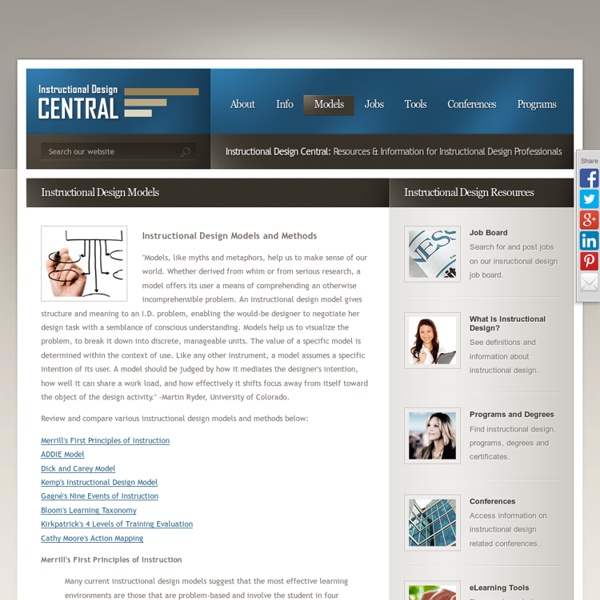Ms. Murphy's World Literature Class
Attention, students! Do you like to move at your own pace? Do you like to have ownership over your learning?
How to become an instructional designer
A lot of people ask me how they could become instructional designers. Here’s some advice from my perspective, followed by links for other perspectives. All of this applies to instructional design in the business world, not academia or K-12 education. It’s probably most applicable to people in the US. Get experience in your current job
Students Thrive on Cooperation and Problem Solving
Project-based learning teaches kids the collaborative and critical-thinking abilities they'll need to compete. Credit: Veer Let's assume the No Child Left Behind Act works fine and that by 2014 every student meets the targeted standards and passes his or her state's exit exam. Will those students be successful as citizens and workers in the twenty-first century?
Oklahoma State University - Stillwater - Home
ADDIE Model | ADDIE Phases | Other Models | More Info Technology is defined as applied science. Engineering is the technology of applying physics to the design of buildings, chemicals, electrical systems, etc.. Instructional design, in comparison, is the technology of applying learning and instructional theory to the design of quality instruction.s Quality of instruction is often measured along three dimensions: effectiveness, efficiency, and cost.
A Letter to Students and Parents
I began writing my course audit for AP Biology this week, which is always a fun thing to do. Part of my course description includes a short letter to parents and students at the beginning, so they have glimpse of my philosophy on the class and school. I also looked back at a course audit I had written for AP Chemistry my first year of teaching.
Review of Clark Quinn’s New Book: Revolutionize Learning and Development: Performance and Innovation Strategy for the Information Age.
One of my favorite people in the workplace-learning space is Clark Quinn. Smart, passionate, and research-based, Clark has been consulting on learning and learning technology for decades. We worked on the Serious eLearning Manifesto together.
Bloom's Taxonomy
Bloom identified six levels within the cognitive domain, from the simple recall or recognition of facts, as the lowest level, through increasingly more complex and abstract mental levels, to the highest order which is classified as evaluation. A description of the six levels as well as verb examples that represent intellectual activity are listed here. Knowledge is defined as remembering of previously learned material. This may involve the recall of a wide range of material, from specific facts to complete theories, but all that is required is the bringing to mind of the appropriate information. Knowledge represents the lowest level of learning outcomes in the cognitive domain.
What Is Curriculum Development?
Mega Worksheets - Take A Quick Look! - 50,000+ Printables
Best Practices « SHSUOnline Blog
Welcome to the Best Practices for Teaching online or as we like to call it: Strategies for Success in your Online Course page. No matter what tool you use or technological journey you embark upon, is the method and not the medium that will help you ensure success in the online, face-to-face and hybrid courses you are teaching. These best practices/strategies will help you with organization, communication, time saving, assessment as well as many other areas. Just looking at this list of best practices, it is easy to understand how you might feel overwhelmed.
What does an instructional designer do?
In the past few months, I’ve been asked by a number of different people what an instructional designer does and how to get into the field. I love instructional design because it is a field where I am constantly learning and I have a great variety in what I do. I use so many different skills—writing, web design, graphics, collaboration, planning, plus of course how people learn. Since this question has come up more than once, I thought it would be useful to collect all the information I have emailed people privately and post it here.
How to Make Lesson Plans for Adult Students
By Deb Peterson Lesson plans for adult education aren't difficult to design. Follow these easy steps and see how effective you can be. Every good course design begins with a needs assessment. For our purposes here, we’re going to assume you’ve completed this assessment and you understand what your students need and what your objectives are for the course you’re designing. If you don’t know your objectives, you’re not ready to design your course.
BlendKit Course
Introduction The BlendKit Course is a set of subject matter neutral, open educational resources related to blended learning developed by Dr. Kelvin Thompson and available for self-study or for group use. Periodically, these materials will also be used as the basis for a facilitated open, online course.
The Accidental Instructional Designer by Cammy Bean
“You may have found your way into this field by accident, but it is what you’re doing in the here and now, so you might as well do it well and with great passion and delight.” When you were a kid, what did you want to be when you grew up? A doctor?
Example 4: Online Journal Rubric - ELC Support
One use of an online journal is to facilitate the documentation of knowledge you are constructing throughout the course. It will help you take control of and direct your own learning experience, identify what you have learned, what questions you have, and what you would like to know more about. You should not only reflect on knowledge gained through materials and discussion, but also new ideas to explore feedback from others.


